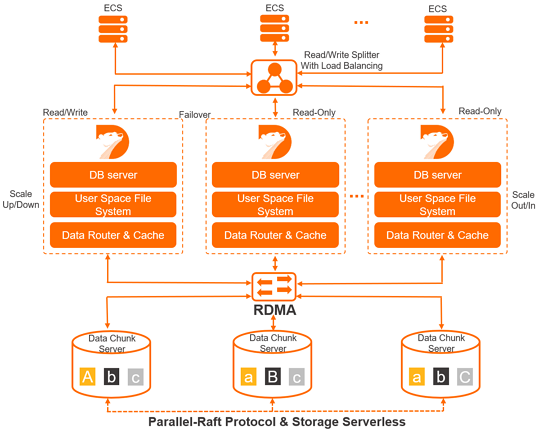PolarDB for MySQL is a cloud-native Hybrid Transactional/Analytical Processing (HTAP) database from Alibaba Cloud. It is fully compatible with MySQL 5.6, MySQL 5.7, and MySQL 8.0, enabling you to migrate existing applications with no code changes.
Built on a modern architecture that decouples compute and storage, PolarDB allows you to scale resources independently, delivering high performance and availability in a cost-effective package.
How it works: Architecture
PolarDB's architecture is co-designed with custom hardware to provide superior elasticity, performance, and reliability. The diagram shows how it works:

Figure 1. PolarDB for MySQL architecture
Single primary, multiple read-only nodes
PolarDB utilizes a distributed cluster architecture. A standard cluster includes one primary node for read- write operations and up to 15 read-only replicas, to ensure high availability and scale read traffic. An active-active failover mechanism between nodes keeps your database online during disruptions.
Decoupled compute and storage
In PolarDB, compute resources and storage resources are separated. Database engine nodes store only metadata, while data and redo logs reside on a remote storage layer. This design minimizes replication lag and allows a replica to be promoted to primary in seconds.
Automatic read/write splitting
PolarDB includes a transparent and highly available load balancing service at no extra cost. Connect to a single cluster endpoint, and your SQL queries are automatically routed to the appropriate primary or read-only node, enabling massive concurrency. For more information, see Read/write splitting.
High-speed network
Compute and storage nodes are connected via a high-speed network using the Remote Direct Memory Access (RDMA) protocol, ensuring that I/O is never a bottleneck.
Shared distributed storage
All compute nodes in a cluster share a single copy of the data, which significantly reduces storage costs. This distributed filesystem allows storage to scale online to hundreds of terabytes without being limited by a single server's capacity.
Data redundancy and the Parallel-Raft protocol
Data is stored with multiple replicas to ensure durability. The Parallel-Raft protocol is used across storage nodes to guarantee data consistency.
Core features
An enhanced MySQL experience
Enjoy 100% compatibility with MySQL and ApsaraDB RDS for MySQL. Migrate your existing databases seamlessly without application code changes.
Beyond standard MySQL, PolarDB offers powerful features like shared storage, stable performance for tables with billions of rows, instantaneous DDL, and non-disruptive failover.
Native HTAP
Run transactional and analytical workloads on a single database system, reducing development and operational overhead.
Analyze your data in real-time without complex and costly ETL pipelines.
Multiple primary nodes (Multi-master Cluster Edition)
All nodes in a multi-master cluster can handle write requests, enabling linear scaling of write performance.
In the event of a node failure, failover completes in 5-10 seconds with no disruption to in-flight transactions.
Worldwide geo-redundancy for disaster recovery
Achieve cross-region disaster recovery. If a region-wide failure occurs, your database remains operational.
The disaster recovery cluster can also serve traffic, improving resource utilization and providing low-latency access for global users.
Nearest access around the world improves business performance.
Why choose PolarDB for MySQL Enterprise Edition?
PolarDB for MySQL offers the familiar experience of MySQL, enhanced with benefits that traditional databases cannot match:
Cost-effective
Smart-SSD technology provides a high data compression ratio without sacrificing performance, reducing storage costs by up to 40%.
Since all nodes share the same storage, adding read-only replicas only incurs compute costs, making it inexpensive to scale out.
Storage auto-scales with your data, so you only pay for what you use.
Highly elastic
Add or remove nodes within minutes to handle planned traffic spikes.
Storage capacity expands automatically online without interrupting your business.
Serverless offering provides scaling in seconds to effortlessly manage unpredictable workloads.
High performance
With a deeply optimized database kernel, physical replication, RDMA networking, and distributed shared storage, PolarDB delivers up to 6x the performance of open-source MySQL.
High availability, reliability, and security
The shared-storage architecture eliminates the risk of data loss from asynchronous replication lag, guaranteeing zero data loss during any single-point-of-failure event.
Data is replicated across multiple zones, with a Recovery Time Objective (RTO) of less than 10 seconds.
The Global Database Network (GDN) provides geo-disaster recovery with an inter-cluster data latency of under 2 seconds.
Security is ensured through a multi-layered approach, including IP whitelists, VPC network isolation, and redundant data storage.
Lock-free backup
Leverage storage-level snapshots to back up terabyte-scale databases in minutes. This process is lock-free, minimizing performance impact on your application.
Available editions
PolarDB for MySQL has the following editions:
Cluster Edition: The standard architecture with one primary (writer) node and multiple read-only nodes.
Multi-master Cluster (Limitless): All nodes in the cluster can handle both read and write workloads. Use this edition to linearly scale write performance.
For more information, see Editions.
Getting started
You can manage your clusters through any of the following methods:
Console: An intuitive web-based graphical user interface (GUI).
CLI: The command-line interface for scripting and automation.
SDK: Integrate cluster management into your applications using your preferred language.
API: Automate operations by calling the PolarDB API directly.
Once your cluster is running, you can connect to it using:
Data Management Service (DMS): A web-based client to connect to your cluster and manage your databases. For more information, see Use DMS to connect to a cluster.
Standard Clients: Any standard MySQL-compatible client, such as MySQL Workbench, DBeaver, or HeidiSQL.